Acer Aspire V3-571G-9435: The Value Proposition
by Jarred Walton on July 4, 2012 4:25 AM ESTAcer V3-571G Gaming Performance
Next up in our test suite are our gaming tests, which we discussed in our 2012 Mobile Benchmark Matrix. We conducted all of the 1366x768 testing with the internal LCD and connected an external 1080p display for the Mainstream and Enthusiast test results. Our Value settings are generally very easy on the V3-571G while the Mainstream settings can sometimes be a bit much and the Enthusiast settings (shown in Mobile Bench) are typically beyond the capabilities of the GT 640M. One of the disappointing decisions Acer made with this laptop is the choice to go with slightly cheaper DDR3 memory for the GPU; while GDDR5 isn’t as necessary at the native LCD resolution, it certainly would have helped with gaming on an external LCD. Of course, we would have liked both GDDR5 and a better LCD, but we tend to be greedy.
Value Gaming Results
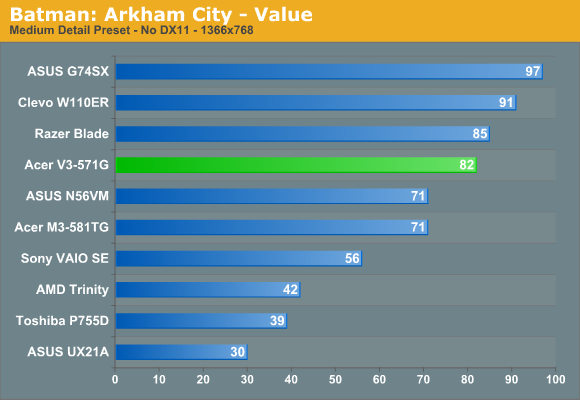
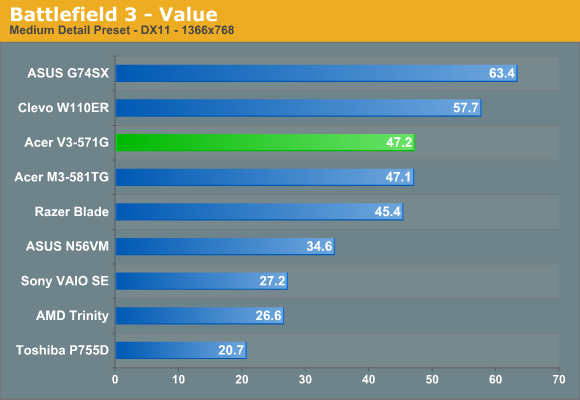

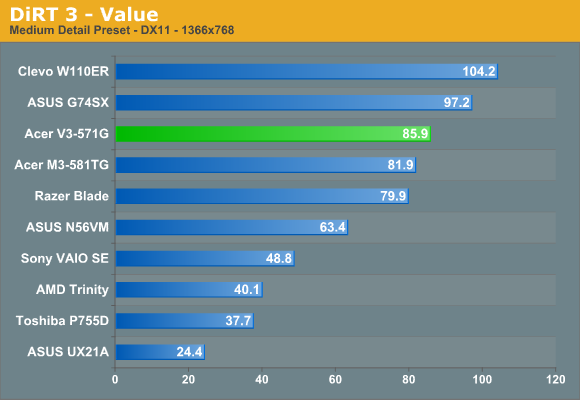
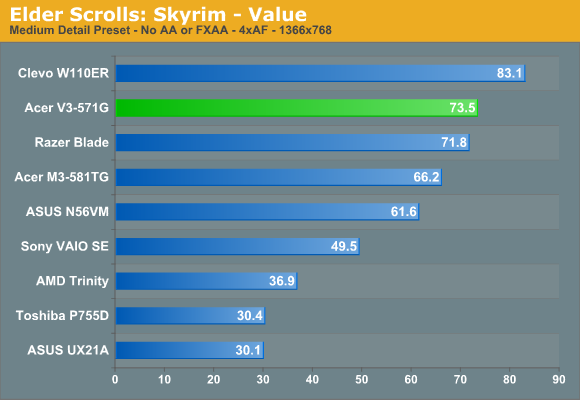
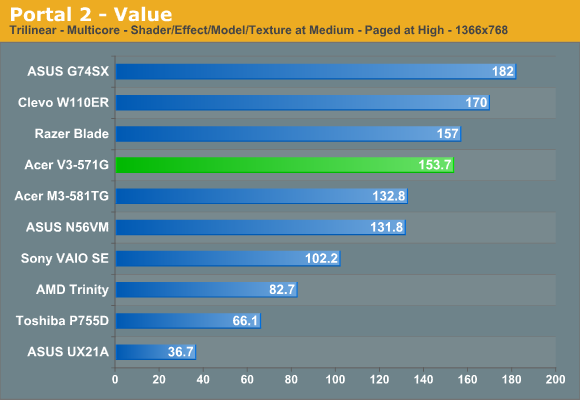
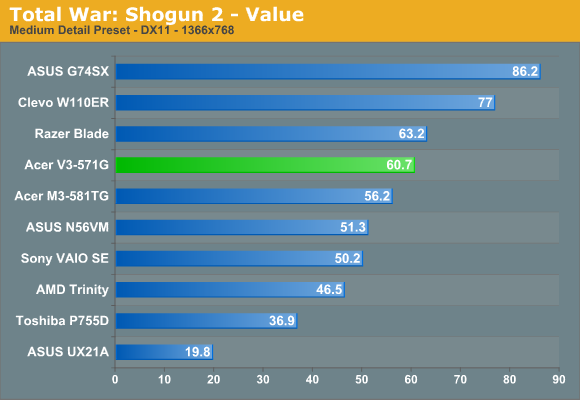
We won’t say too much about our Value settings, other than the V3-571G is more than capable of running all the test games at these settings without difficulty. Civilization V was initially the odd man out, with performance coming in just shy of 30FPS at 28.3; however, the just-released-yesterday 304.79 beta drivers have improved Civ5 performance by around 15%, pushing Civ5 up to 33.4FPS. I still feel it’s possible the current NVIDIA drivers aren’t optimized very well for mobile Kepler, but how much more performance they can eke out with driver updates remains to be seen. The previous generation GT 555M in the Razer Blade is still 10% faster than the GT 640M, and AMD’s A10 Trinity chip is nipping at the heels of what should otherwise be a much faster GPU. The GT 650M in the W110ER also comes in a whopping 65% faster (with a core clock that’s only 18% higher), so something is certainly odd with the current Civ5 results. The V3 breaks 60FPS in nearly all of the other games, Battlefield 3 being the other exception (though at 47FPS it’s certainly fast enough for multiplayer gaming).
Note that in all of these games, the Clevo W110ER with the faster clocked GT 650M (but still with 2GB DDR3) easily outperforms the GT 640M, suggesting that at least for our Value settings memory bandwidth isn’t a bottleneck. The GT 555M GDDR5 on the other hand trades blows with the GT 640M, winning several matchups but falling slightly behind in others. In terms of compute power, the GT 640M should win out by roughly 20%, but the GDDR5 memory gives the GT 555M nearly 40% more bandwidth, with the result being a pretty even fight. Let’s see what happens at our more demanding Mainstream settings.
Mainstream Gaming Results
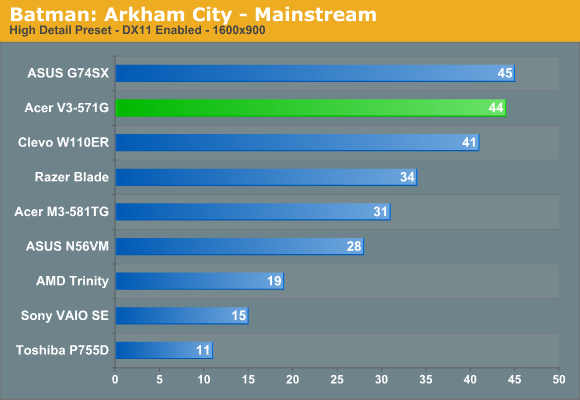

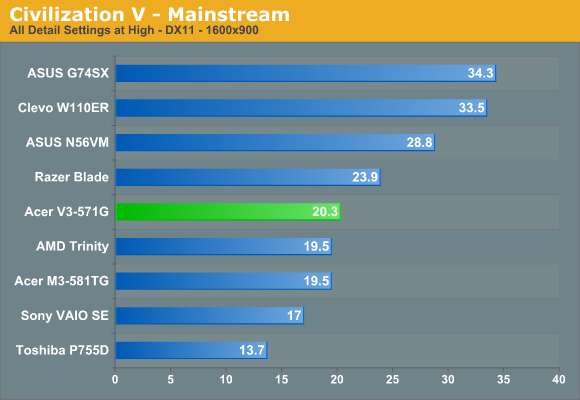


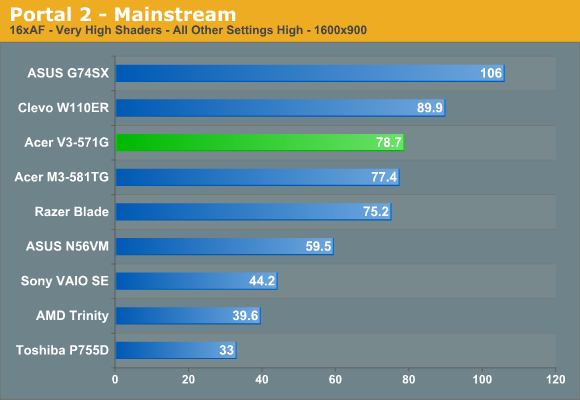

With the increase in detail levels and resolution, performance drops are pretty significant. The V3-571G manages to stay above 30FPS in all of the titles, with the exception of Civilization V, but frame rates are low enough in BF3 that we’d recommend using lower settings for multiplayer. The Razer Blade likewise continues to trade blows with the V3, indicating we’re still pretty balanced between memory and shader requirements. Of course, outside of gaming on an external display, no one would actually be running at our 900p Mainstream or 1080p Enthusiast settings, so we put together another table with our recommended settings and the performance you can expect.
Recommended Gaming Settings and Performance
|
Acer V3-571G-9435 Gaming Recommended Settings for 1366x768 |
|||
| Detail | FPS | Notes | |
| Batman: Arkham City |
Very High + Normal PhysX + High FXAA |
34 | You can run either DX11 or PhysX at decent frame rates with the GT 640M, but PhysX in my opinion looks better than DX11. FXAA is basically "free". |
| Battlefield 3 | Ultra + 1xAA | 37.8 | Single-player is fine at these settings, but multi-player might need to drop down to high or even medium settings. |
| Civilization V | Low (“Value”) | 33.4 | Unless NVIDIA can further improve Civ5 performance with a driver update, stick with our “Value” settings (though you could turn up a few knobs). |
| DiRT 3 | Ultra + 4xAA | 32.4 | If you’re a stickler for maintaining >30FPS frame rates, you should probably disable AA. |
| Portal 2 | Max + 4xAA | 79.3 | Portal 2 is one game in our suite where you can basically max out all settings without any concern for performance. Have fun! |
| Skyrim | Ultra + 4xAA | 34.9 | Skyrim also plays quite well at the Ultra defaults, though we recommend setting AA to 4xAA instead of 8xAA. |
| Total War: Shogun 2 | Very High | 38.5 | Maximum detail works fine for this game, though you may need to edit the INI file to specify VRAM in order for the Very High preset to unlock. |
Most of the games in our test suite run fine at close to maximum detail at the LCD’s native resolution. You can read our testing notes from above, and the only games that need lowered settings are BF3 and Civ5 (surprise). I also ran a test of Diablo 3 (Nightmare difficulty, midway through Act 1) and found that even 1080p at maxed out settings (with the newly added “High (Smooth)” shadowing enabled) was playable on an external LCD, with an average frame rate of 38FPS over 30 minutes. During that period, there were only four dips below 20FPS, with frame rates staying above 30FPS 91% of the time and above 25FPS 99.5% of the time. Of course, if you play on the integrated laptop display you won’t have any issues with frame rates whatsoever. [Ed: Battle.net lag on the other hand….]
The short summary of the gaming results is that the V3-571G definitely has sufficient performance for running any modern game, though not always at max quality. If you prefer gaming performance put into perspective, today’s mainstream GT 640M is generally faster than the GTX 285M from a couple years back, and it consumes less than half the power. It’s also a pretty good match up against the Radeon Mobility HD 5850 and GTX 460M—again, while using substantially less power. With GDDR5 memory, the GT 640M would likely outperform both of those cards.










88 Comments
View All Comments
StormyParis - Wednesday, July 4, 2012 - link
It's an article of faith among tech reviewers that SSDs are where it's at nowadays. I have doubts:1- Size: especially on a laptop, I'd rather have a large HD on which I can stick a few games, 10+ hours of films for me and the kids. AN SSDs pretty much means you *have* to carry an external HD. Or read getting bored.
2- Reliability: the only reliability survey I ever saw says SSDs fail on average almost twice as much as HDDs.
3- limited use case: very few apps do a lot of disk I/O once launched, and 4GB systems mostly don't swap, so SSDs are mostly useful during boot and app launch. Also, many users now do sleep/hibernation with apps open, instead of a full reboot + apps relaunch. That makes for a scarce few seconds when the SSD will be felt.
I'm fairly sure reviewers aren't needing hours of videos during their reviews (they're at work, not snowed in with the kids ^^), do full startups (and few of those), and are given somewhat pre-tested units. Isn't there a big disconnected between reviews and users ?
Omoronovo - Wednesday, July 4, 2012 - link
1. For a laptop, you're unlikely to have many games installed that are dedicated, hardcore games that take up 25GB of space each. Diablo 3 et al are all relatively large games, certainly, but you will know which ones will be playable on a machine like this and you will be clever enough to plan accordingly. As for movies, having anything higher than 720p on a machine with this resolution is pointless; and even at maximum quality (again, ruined on a panel of this quality, but for arguments sake), you're talking about 40GB of movies for 10 hours of potential playback. A 128GB ssd would be enough to cater to both of these with space to spare.2. Unless you can cite your source for this survey, we can't really comment on its validity. Solid state drives have come a long way; I have no doubt that drives like my first generation Indilinx-based SSD have higher failure rates, but that's the price for early adoption. They are far, far more reliable now, with Sandforce being able to de-dupe and compress data so that only a fraction of nand is physically written to (whereas early Indilinx based drives had insane write amplification, wearing nand far faster than necessary for the sake of performance).
3. SSD's make a tangible "snappiness" improvement to your machine. This is especially noticeable with Windows due to the way it prioritizes data in ram. Take a theoretical example: Opening control panel. On a standard disk based system, each and every file called needs to be accessed from disk; excluding those files already loaded (like the ui elements as those are shared with all standard explorer windows). If there are 30 files to access, with a standard disk you will have as much as 450ms latency to get all of those files loaded into ram and the panel opened, not to mention any processing time (ordering of icons and such). This is only half a second, that is true. Scale this up with all file and folder access on the machine (from all programs, devices, and services, bearing in mind that when multiple programs try to access the disk (HDD) at once, the latency is exacerbated), and you quickly realize why using an SSD makes such a huge improvement to the day to day usability of a machine.
In my case, personally, I noticed far more of an upgrade in my day to day use of my machine when I upgraded to a SSD, than I did upgrading to a core i7-920 from a Core 2 duo E7200.
One final point I'd like to make: Although this laptop doesn't, there is nothing preventing a manufacturer dropping optical storage and using the space for a hybrid disk drive and SSD setup. When Windows 8 ships and OEM's start tearing into the Storage Spaces feature, "normal" people won't even have to go out of their way to move bulk data onto the disk drive, as windows will do it automatically and merge the SSD and HDD space into one contiguous area. Just something to think about.
Rollo_Thomasi - Thursday, July 5, 2012 - link
Even if the OEM:s usualy favors an ODD over a SSD HDD combo you can simply replace the ODD yourself.Here is an article on that:
http://www.extremetech.com/computing/131697-ivy-br...
Christopher29 - Wednesday, July 4, 2012 - link
1. Agreed, size still is not enough ...2. Completely untrue - see forum xtremesystems thread: SSD-Write-Endurance-25nm-Vs-34nm/page195 - where users intentionally try to wear out SSDs, most of them hold from 600TB - 800TB, and 256GB Samsung 830 holds 2,500TB Host writes. Everyone died after stating correct S.M.A.R.T warnings.
For your perspective, I have written 3,8TB of data on my SSD since 2009 and this is 1/200 (0,5%) of possible writes that this SSD will handle - in other words - this SSD will outlive two to three laptops in which it will be used.
3. You tottaly don't know (and probably used) anything what You've just written in this point.
piroroadkill - Wednesday, July 4, 2012 - link
What are you even talking about? You can get 256GB SSDs for a very reasonable price these days, job done.Less power use, less likely to die in the manner that is MOST caused by use in laptops - knocking the heads around...
I would say maybe you can't afford an SSD, but really, very recently the prices have come right down to the point where there's no reason not to have one..
jabber - Wednesday, July 4, 2012 - link
Yes I picked up a SATA2 120GB SSD for $100 a few weeks ago.Why SATA2 well as my laptop only runs SATA2 I felt it pointless to get a 500MBps capable SSD when it will only run at half that speed.
Oh and its cheaper. Anyway instead of the WD Black 320GB drive giving me 85MBps I now have an SSD giving me around 275MBps. Big improvement especially in access times.
zorxd - Wednesday, July 4, 2012 - link
$780 is a high end laptop. Most people by laptops cheaper than that. This review sounds like the review of a BMW by a Ferrari owner, saying that the BMW is OK if don't care about cheap build quality and bad performance.zorxd - Wednesday, July 4, 2012 - link
The average selling price of a windows laptop was $513 in the US in February 2012.JarredWalton - Wednesday, July 4, 2012 - link
Where exactly does that stat come from, and what happens if you remove netbook class hardware from the list? Netbooks (and ultraportables like the 11.6" stuff with Brazos) are very inexpensive, but if people want to complain about this Acer's quality they should be even more harsh on such laptops. Regardless, $780 is hardly high-end for a laptop; it's at most lower-midrange pricing.zorxd - Wednesday, July 4, 2012 - link
http://blog.laptopmag.com/the-average-pc-laptop-co...netbooks or not, $780 is still much more than the average price for a laptop.
And this is only in the US, a rich country. The average of the world is probably much lower.